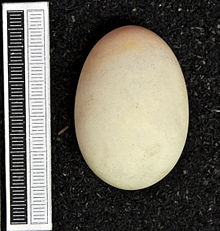Pigeon petrel
| Pigeon petrel | ||||||||||
|---|---|---|---|---|---|---|---|---|---|---|

Pigeon Petrel ( Pachyptila desolata ) |
||||||||||
| Systematics | ||||||||||
|
||||||||||
| Scientific name | ||||||||||
| Pachyptila desolata | ||||||||||
| ( Gmelin , 1789) |
The pigeons Petrel ( Pachyptila desolata ), also known as the Antarctic billed Prion referred to is a species from the genus of prions ( Pachyptila ) within the family of Petrel (Procellariidae). There are up to three subspecies.
features
The pigeon petrel reaches a size of 25 to 27 centimeters and a weight of 150 to 160 grams. The wingspan is 58 to 66 centimeters. The middle of the lower tail is black like the thin-billed petrel ( Pachyptila belcheri ) but has a thicker black terminal band. An incomplete, distinct, wide, dark gray band runs across the chest. The juvenile birds are indistinguishable from the adult birds. There are differences between the subspecies in terms of the width of the beak and the length of the wings and tail.
There is a possibility of confusion with all species of whale birds . The similarity with the little duck petrel is particularly pronounced , and can hardly be distinguished when observing the field. However, the beak of the pigeon petrel is slightly shorter and less wide at the base than that of the lesser duck petrel.
Subspecies and their distribution
The nominate form Pachyptila desolata desolata breeds on the Crozet Islands , the Kerguelen and the Macquarie Islands . Breeding colonies of the Pachyptila desolata alter breed can be found on the Auckland Islands and Heard Island . The breeding areas of the subspecies Pachyptila desolata banksi are known from South Georgia and the South Sandwich Islands , the South Orkney Islands , the South Shetland Islands and the Scott Island .
habitat
Outside of the breeding season, the petrel can be found above the high seas far from the coast. It occurs in the cold waters north of the pack ice . They breed on slopes in tussock grass , in crevices, in scree or on cliffs.
food
The pigeon petrel feeds on crustaceans , especially krill ( Euphausia superba ), copepods ( Calanoides acutus ), amphipods ( Themisto ) and small amounts of fish and squid.
Reproduction
The breeding season usually starts in November. However, it can be delayed if the snowfall is too heavy. The birds nest in dense colonies. The clutch consists of an egg that is laid in caves, cracks or in a crevice. The incubation period is 44 to 46 days. The chicks have blue-gray down plumage. The young are fledged after 45 to 55 days.
hikes
After the breeding season is over, all birds leave the colony and presumably move north. They hunt widely distributed over the waters of the South Atlantic and the southern Indian Ocean, where they can be seen from the pack ice to the subtropical latitudes of South America. There is evidence north of the 12th parallel in Peruvian coastal waters as well as in the waters south of Australia and South Africa.
Existence and endangerment
The pigeon petrel is not endangered and is widespread. In the 1990s, the total population was estimated to be many million individuals, including 22 million pairs in South Georgia and 2,000,000 to 3,000,000 breeding pairs on the Kerguelen.
supporting documents
literature
- Josep del Hoyo et al .: Handbook of the Birds of the World. Volume 1: Ostrich to Ducks. Lynx Edicions, 1992, ISBN 84-87334-10-5 .
- Hadoram Shirihai: A Complete Guide to Antarctic Wildlife - The Birds and Marine Mammals of the Antarctic Continent and Southern Ocean , Alula Press, Degerby 2002, ISBN 951-98947-0-5
Single receipts
Web links
- Videos, photos and sound recordings of Pachyptila desolata in the Internet Bird Collection
- Pachyptila desolata in the endangered Red List species the IUCN 2012. Posted by: BirdLife International, 2012. Accessed November 17, 2012th
